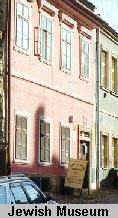The History of Malinec
The first mention of a Jew in Boskovice was around 1343. Klenovsky says in his booklet (The Boskovice Ghetto) that the Jews of Brno went to Boskovice after they were banished from the Moravian Royal Towns in 1454. At that time the Jews had restricted rights and paid high premiums to be allowed to live in the town. But, by 1589, there were 148 Jews living in 25 family houses. In 1727 when the ghetto was set up and the the first complete register written, the numbers had grown to 1531 Jews living in 38 family houses, 97 extensions and 40 cottages. Jews in the 17th century worked as butcher, tailor, barber, purse maker, goldsmith, red and white tanner, leather worker, sword blade maker, cabinet maker, furrier, cap maker and others. In a real estate survey of 1677, Jews owned nearly 23 hectares including arable land.
The town's memorial books mention fire and epidemics which affected both Christians and Jews. In 1715 and the following year, a plague ravaged the entire population and 200 Jews died.
Before the Josefinian reforms, Jews used mostly Hebrew/Yiddish or Czech names - for example: Jakub Markus, Kalman, Israel, Pinkas, Lev Kain, Lebl Salomon, Abraham, Nathan and, for women, Lida, Manda, Juettl, Resi, Nettl, Friedl.
Further Jewish settlement was prohibited by the "Familianten "law of Emperor Charles VI in the 1820's which allowed residence of only 326 Jewish families. Bransky's book includes the list of all male heads of those families taken in the tax census of 1799. The first ten names in the list are: Dawid Thorsch, Jakub Beamt, Dawid Schreiber, Salomon Friedmann, Markus Friedmann, Abraham Lewue, Simon Husserl, Jakob Husserl, Dawid Eisner, Feit Husserl.
At the turn of the 18th century there was an active yeshiva and by the mid-19th century the Jewish population comprised one-third of all Boskovice inhabitants.
The Jewish town had serious problems with fires, most likely due to overcrowding. The worst one occurred in 1823, when practically two-thirds of the entire town burned down.
The emancipation struggles in Europe culminated in 1848; by then, the Jews benefited from a relaxation of restrictions dating to the Middle Ages. By 1848, Jews were allowed to live where they wished. The zenith of Jewish settlement recorded in Boskovice occurred in 1857 when the restrictive laws were repealed At that time, 1810 people of the Hebrew faith lived in the town. Under the Josefinian laws, Jews no longer had to wear special insignia on their clothing, but they had to choose German names and German was decreed to be the official language for Jews. To obtain permission to marry, a Jew had to pass a German test.
The Boskovice Jewish Quarter was established as a separate political entity with its own authorities, existing until 1919, just after the first Czechoslovakian Republic was established. In the Second World War, only 14 of the 458 Boskovice Jews survived a forced deportation to Terezin and other concentration camps. Among those sent to Terezin were my grandfather's cousin Izidor THORSCH and his wife Henrietta (nee BERGMANN).
Boskovice was one of the largest Jewish communities in Moravia and was known as a centre of prominent Talmudist scholars. The most famous of these scholars was Samuel ha-levi Kolin; he is buried in the local Jewish cemetery.
In 1851, the Boskovice Rabbi Placek was appointed Chief Rabbi of Moravia until 1884.
Boskovice Jews worked mainly in the restricted occupations of trade, commerce and crafts but, in the 19th century, they began to establish industrial production in Boskovice and other nearby Moravian towns. Families who built up factories in Boskovice included Eisler, Czaczkes and Ticho, and in other towns, Loew Beer, Popper and Biach.
In particular, the Jews founded the textile industry, with the Schwarz family being most prominent. The Loew Beers established a woolen plant, and Salomon Biach, Markus Ungar and Moritz Knopfelmacher started making alcohol and liquers. Jews were especially well-recognized for founding the fashion industry in machine-equipped factories. The Ticho brothers and Sigmund Munk were successful producers of ready-made clothing.
After the first Zionist groups began at the turn of the 20th century, the 1930's saw the start of migration to Palestine.

 The Jewish Quarter that remains today is a vast complex between the castle area and the historical
core, encompassing 5 hectares, 13 streets and 79 preserved houses (of the original 138). More
than 25 of the existing and remaining Jewish buildings have been declared national monuments and
so are protected by the State. Remaining sites of interest include a school at 7 Bilkova street,
a spa at u Koupadel 8, a hospital ve Spitalku 10, a rabbinate at Plackova St 45, a mikvah in the
house at Zborovska St 9, the ghetto gate and a fountain from 1875. In the house at Plackova St no
6 is a small museum with exhibits of the history and memories of the Jewish community, open from
10 A.M. to 4.30 P.M. daily except Mondays.
The Jewish Quarter that remains today is a vast complex between the castle area and the historical
core, encompassing 5 hectares, 13 streets and 79 preserved houses (of the original 138). More
than 25 of the existing and remaining Jewish buildings have been declared national monuments and
so are protected by the State. Remaining sites of interest include a school at 7 Bilkova street,
a spa at u Koupadel 8, a hospital ve Spitalku 10, a rabbinate at Plackova St 45, a mikvah in the
house at Zborovska St 9, the ghetto gate and a fountain from 1875. In the house at Plackova St no
6 is a small museum with exhibits of the history and memories of the Jewish community, open from
10 A.M. to 4.30 P.M. daily except Mondays.